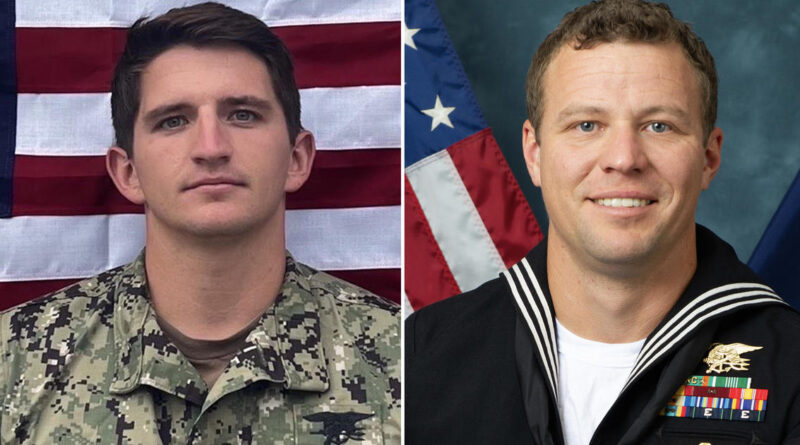Drownings of 2 Navy SEALS were preventable, military probe finds
Washington — Early one morning last January, off the coast of Somalia, Special Warfare Officer Christopher Chambers reached for the slick handrail of a Houthi vessel from his team’s combat craft. The seas shifted and he lost his grip, falling into the water. Within seconds, Special Warfare Officer First Class Nathan Gage Ingram jumped in to save his fellow Navy SEAL. Both men sank beneath the waves of the Arabian Sea within 47 seconds.
A new report by the U.S. Navy has concluded that both men’s deaths were preventable, but exactly why the deaths of two elite Navy SEALs were not prevented is more murky.
The Navy’s report on its eight-month investigation, obtained by CBS News, cites a catalogue of shortcomings, from a lack of proper training and equipment malfunction or misuse, to a failure to compensate for extra weight the men were carrying. But their deaths come down to the fact that the two SEALs operating on the small combat vessel were too heavy, laden with equipment, to stay afloat long enough to be rescued.
U.S. Navy
Chambers, 37, from Maryland, and 27-year-old Ingram from Texas were posthumously promoted by the Navy. The men were part of SEAL Team Three/Task Force Three, and they were on a mission to intercept Houthi vessels suspected of smuggling Iranian weapons to Yemen. Those weapons have been used by the Iranian-backed rebels in Yemen to attack U.S. Naval vessels and commercial ships in and around crucial Red Sea shipping lanes for more than a year, since the Israel-Hamas war in Gaza in Gaza began.
The heavily redacted report details the series of events that led to their deaths.
The environmental conditions were “near or at the threshold” for the mission, the report written by Rear Admiral Michael Devore says — “not causal to this terrible mishap, but a contributing factor.”
According to the report, classified and unreleased images of the two men show they were both equipped with flotation devices called Tactical Flotation Support Systems (TFSS) before the operation to board the suspect Houthi vessel on January 11. While attempting to hoist himself onto the Houthi boat from the SEAL combat craft, Chambers slipped and fell nine feet into the water.
“Observing his teammate struggling, (Ingram) jumped into the water to render (Chambers) assistance,” the report says. “Encumbered by the weight of each individual’s gear, neither their physical cability (sic) nor emergency flotation devices, if activated, were sufficient to keep them at the surface.”
It’s unclear whether their flotation devices would have been enough to keep them afloat even if they were activated. Chambers was laden with nearly 50 pounds of gear. Ingram, carrying an additional backpack with the team’s radio, was an additional 30 pounds or so heavier.
The SEALs had put a trailing ladder on the dhow, but Chambers, like some of the SEALs who had already boarded the Yemeni vessel, opted to reach for the rail. In video shot by a U.S. helicopter hovering 200 feet overhead, he’s seen “intermittently at the surface in the subsequent 26 seconds after his fall. (Ingram) was only intermittently at the surface in the 32 seconds following his entry to attempt a rescue. The entire tragic event elapsed in just 47 seconds, and two NSW warriors were lost to the sea.”
It happened too fast for the other SEALs to mount man-overboard rescue efforts. A 10-day search and rescue operation found nothing apart from one of the lost SEAL’s flotation devices. The report notes that the sea is about 12,000 feet deep in the area.
The flotation devices either failed to inflate, detached from the men, or were too wedged by other gear to fully inflate, the investigation report says.
“The Navy respects the sanctity of human remains and recognized the sea as a fit and final resting place,” according to the report.
The report outlines the following issues related to the incident:
- A failure to recognize risks to buoyancy and the role emergency flotation devices sand supplemental buoyant material should play in achieving buoyancy.
- Failure to complete buoyancy tests once deployed.
- Insufficient training with the Tactical Flotation Support System
- Conflicting guidance and lack of implementation of buoyancy requirements
- Maintenance of TFSS did not meet Navy standards
The SEAL team did find weapons aboard the Houthi dhow, a U.S. Navy Official has since confirmed.
“We extend our deepest condolences to the families, friends and teammates of Chief Special Warfare Operator Christopher J. Chambers and Special Warfare Operator 1st Class Nathan Gage Ingram,” U.S. Navy Commander Timothy Hawkins said. “Chambers and Ingram were part of a team that interdicted an illegal shipment of Iranian-supplied ballistic-missile and cruise-missile components, preventing them from reaching Yemen. During this operation, the Navy lost two noble warriors at sea. We mourn their loss and we remember them as heroes who died defending our nation.”
The report makes several recommendations, including a review of training and tactics, risk management clarifying buoyancy guidance, and the formalization of pre-mission “buddy checks.”
“This incident, marked by systemic issues, was preventable,” General Michael Kurilla, commander of the U.S. military’s Central Command, says in the report.
A SEAL team’s embarkation between vessels at sea is regarded as one of the most hazardous phases of a mission.
“However, a layered defense of personal responsibility, properly maintained and functional equipment, and process and procedures safeguard against such a hazard,” according to the report.
Whether it was a lack of those processes and procedures, or a combination of failures that led to the two SEALs’ deaths will never be fully known. The evidence is at the bottom of the Arabian Sea.



